In Aguadilla’s Residencial José A. Aponte public housing project everything is uncertain. While the Public Housing Administration (AVP, in Spanish) has it on its list for possible demolition because it is in a flood prone zone, residents are unaware of the details or where they will live.
Ana María Esteves, who has lived in this complex for 58 years, confirms that she found out about the possible demolition from her neighbors, but so far, American Management, the company that manages the housing project that has been her home for “a lifetime,” has not said anything about those plans.
Wilfredo Benejan Acevedo agreed with her. He heard of the government’s intentions through comments from people and on the radio. He is worried, he said, since he has been living there for 40 years with his mother. Other relatives also live in the complex. If he eventually has to leave, he hopes he can at least stay in Aguadilla.
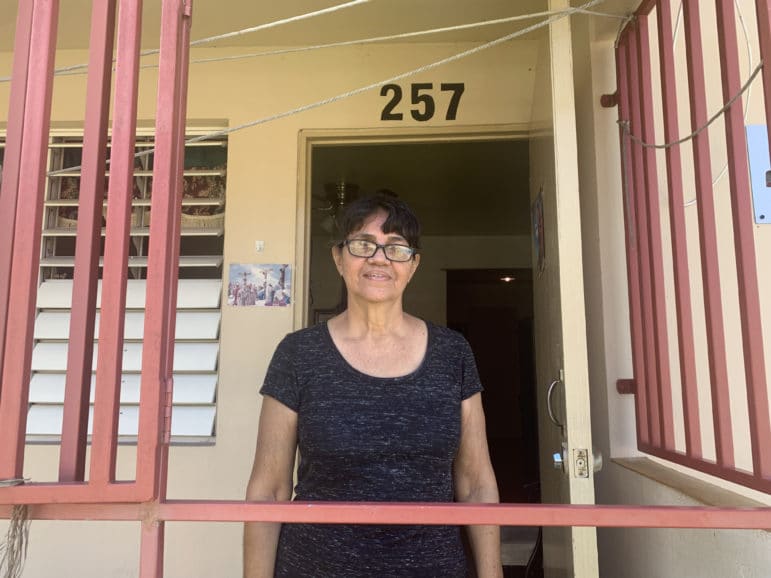
Photo by Jeniffer Wiscovitch Padilla | Centro de Periodismo Investigativo
Ana Carrero, president of the Residents Council of that housing complex is constantly fielding this concern, when the neighbors approach her worried about the possible demolition and where they will live. On April 10, she met with the Secretary of the Department of Housing, William Rodríguez, and with the administrator of Public Housing, Alejandro Salgado Colón, to discuss the matter at the agency’s headquarters in San Juan. There they told her that the final decision of what will happen with the housing complex may come down soon or could take years.
Despite being on the AVP’s demolition list, this project does not yet have demolition approval from the US Department of Housing and Urban Development (HUD), which would pay for knocking it down. Furthermore, Secretary Rodríguez told the Center for Investigative Journalism (CPI, in Spanish) that the demolition could be avoided if work is carried out to channel the Culebrinas River.
Rodríguez said that he has already had a first meeting with the US Army Corps of Engineers, which has money allocated by US Congress to carry out these channeling works. However, he said he will meet again with USACE, as well as with HUD and the Federal Emergency Management Agency (FEMA) “to find out what alternatives” they have for the housing complex.
What remains to be seen, Rodríguez said, is “if this is a measure that will mitigate and eliminate the flooding condition and the structure can stay in place, or if, on the contrary, the imminent danger remains in the community that requires the demolition and relocation of the community elsewhere.”
If the demolition option prevails and HUD approves it, the AVP said the families would be relocated to other public housing locations, through vouchers under the Section 8 Program, or to other available public housing units. The AVP’s Annual Plan anticipates that the demolition of these units be carried out in fiscal year 2022-2023.
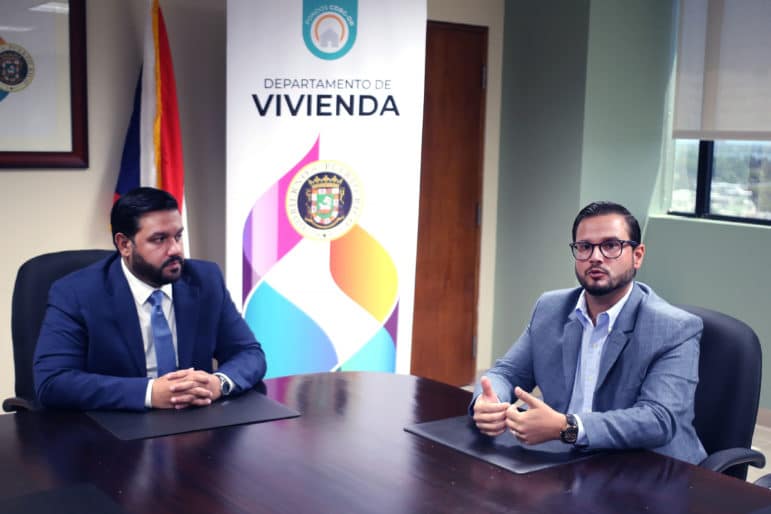
Photo by Jose “Pipo” Reyes | Centro de Periodismo Investigativo
Rodríguez explained that when a public housing complex has a flood problem and is covered by FEMA, the project to be demolished must be replaced by another or other projects with the same number of units somewhere else where it is not subject to flooding. HUD also must approve the new project’s location, which cannot be isolated, but must instead be close to medical facilities and businesses, he said.
However, he did not give further details of where they would be building the new project.
As with the Residencial José A. Aponte, the AVP plans the demolition of the Los Peña (San Juan), Los Cedros (Trujillo Alto), Alturas de Ciales and Dos Ríos (both in Ciales), five buildings on the ground floor of Residencial Nuestra Señora de la Covadonga (Trujillo Alto), one building of Residencial Villas del Cafetal (Yauco), four buildings of Residencial Padre J. Nazario (Guayanilla), Mattei III (Jayuya) and Brisas del Mar (Salinas).
There are 328 public housing projects in Puerto Rico, Salgado Colón said. Some 100,000 people live in them, according to recent data from HUD. A total of 1,169 housing units are on the demolition list. A total of 492 families still live in these units to be demolished.
The CPI was able to confirm that people who lived in these residential complexes in the process of being demolished have not been informed of the government’s plans nor have they been provided with housing options while the demolition processes are taking place. Some of these people currently live in dangerous conditions.
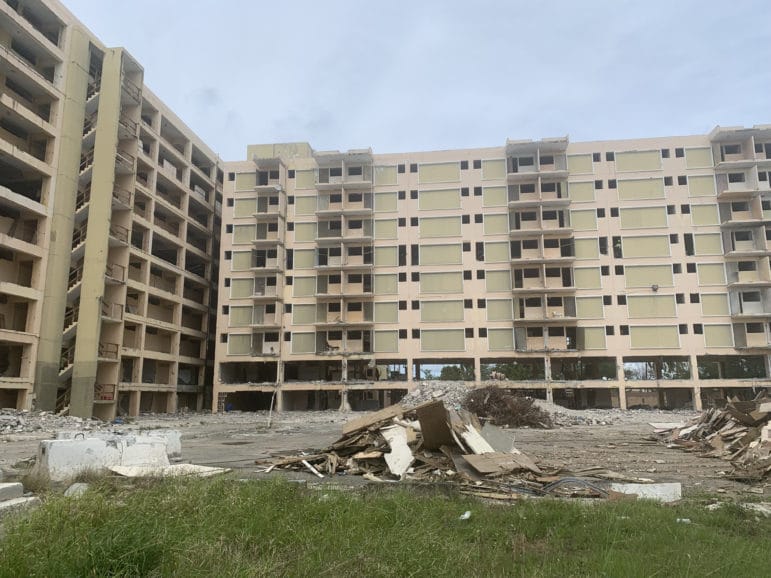
Photo by Jeniffer Wiscovitch Padilla | Centro de Periodismo Investigativo
According to information provided by the AVP, once the Los Peña and Los Cedros residential complexes are demolished, construction of mixed-income complexes is planned in that area, as well as in Torres de Sabana, a public housing complex in Carolina that began to come down last year. Both developments would be demolished because they are obsolete. They already have permits from HUD.
In addition, the AVP confirmed that for the other projects (Brisas del Mar, José Aponte, Alturas de Ciales, Dos Ríos, and Padre Nazario) developing new public housing units is planned to replace those that are demolished.
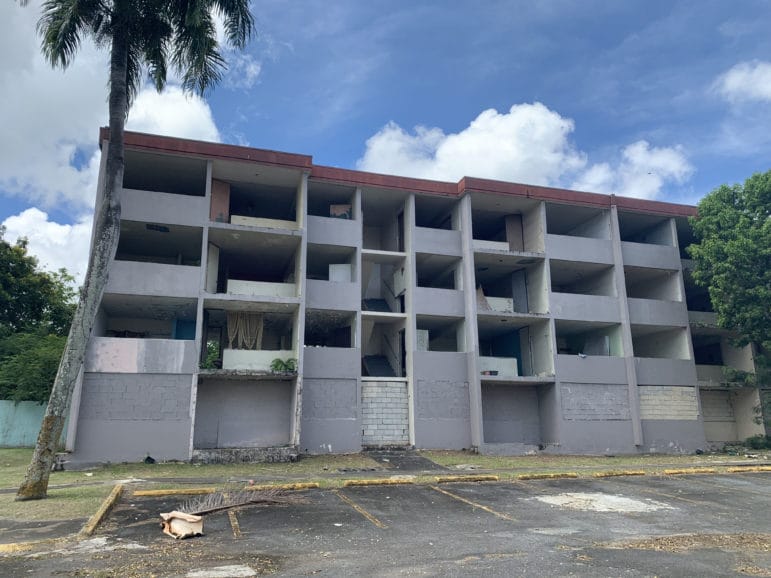
Photo by Jeniffer Wiscovitch Padilla | Centro de Periodismo Investigativo
“The [Los Peña] complex is more than 40 years old and has the following conditions: degradation and defects caused by aging, wear, and weather, as well as fatigue of materials and structures. In addition, the project showed problems of overflow of the sanitary sewer system and serious problems of erosion, affecting the quality of life of the residents given the current condition of the units,” the AVP said in written statements. This demolition will be paid for with HUD funds, it added.
In the case of Residencial Los Cedros, whose 18 floors were built about 50 years ago, the AVP assures that its “electrical and plumbing systems are in an advanced state of deterioration” and has structural flaws in the buildings. “To address these failures, the possibility of carrying out a rehabilitation of the buildings through a comprehensive retrofit was evaluated, [a cost study where it is determined if it is cost-effective to repair or if, on the contrary, it is better to replace]. However, the solution [rehabilitation] is not cost-effective,” according to the AVP.
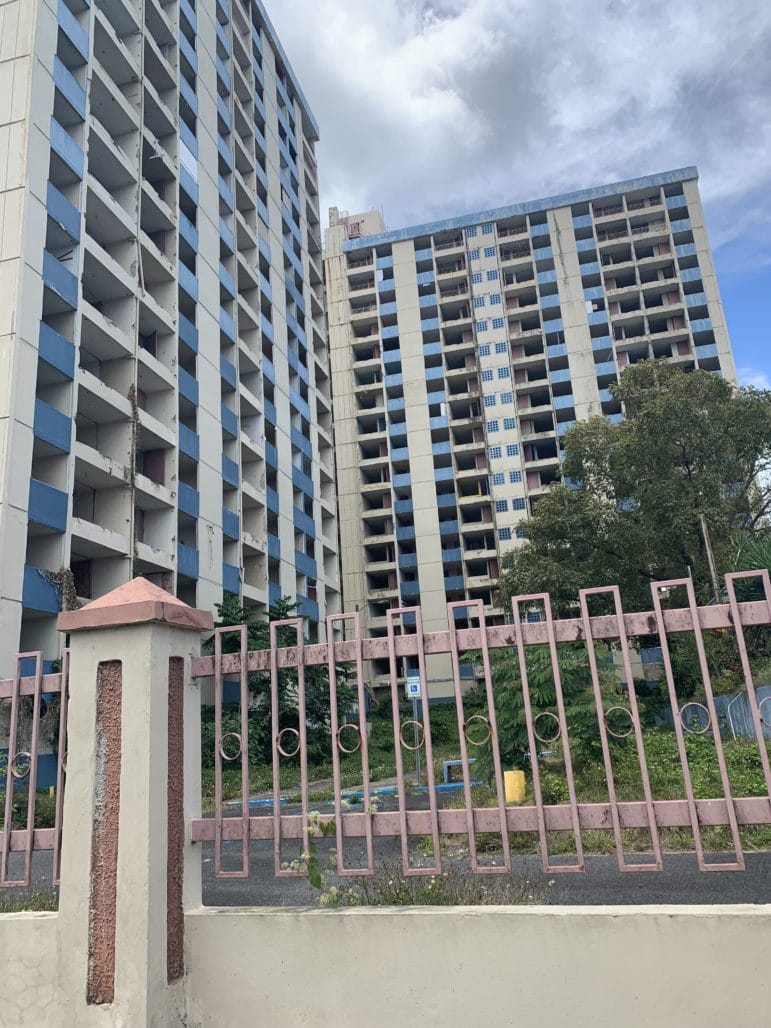
Photo by Jeniffer Wiscovitch Padilla | Centro de Periodismo Investigativo
On the other hand, the five buildings of the Residencial Nuestra Señora de la Covadonga that will be demolished, experience ongoing sanitary overflows, which affects the residents’ health and quality of life, according to the AVP.
As for residential complexes Mattei III in Jayuya, Brisas del Mar in Salinas, and Alturas de Ciales and Dos Ríos, in Ciales the AVP confirmed that they will be demolished for safety reasons, as they are in flood zones. However, until now, only the Ciales housing complexes have the HUD demolition permit. The AVP will build a housing project in the municipality of Ciales to relocate the 110 families that live there, those who are currently living in other residential areas or those who received vouchers under the Section 8 Program.
Matei III has the Rio Grande de Jayuya flowing behind it, which overflows its banks during episodes of rain and floods the units on the first level of the buildings. The Agency’s Plan proposes that the demolition of these units be done in the 2023-2024 fiscal year, which begins on July 1 of that year, the AVP stated.
In the case of the Ciales residential complexes, the AVP confirmed that a large part of the area where they are located is susceptible to flooding and that another segment falls within an area with a 0.2% probability of a flood occurring each year. After Hurricane María struck, both public housing complexes suffered catastrophic damage due to flooding caused by the Río Grande de Manatí and one of its tributaries, the Cialitos River in Ciales.
In Salinas, the AVP stated that, according to the Agency’s Annual Plan, pre-demolition work would begin in fiscal year 2022-2023. Demolition would be in fiscal year 2023-2024.
Dr. Jennifer Santos, a professor at the Center for Social Research at the University of Puerto Rico in Río Piedras, said the housing projects that will be demolished because they are obsolete reflect a prolonged lack of maintenance, which has been an ongoing challenge for the Housing Department.
“The story is basically the same as with Las Gladiolas, which was about saying ‘we are going to destroy this building that’s obsolete, condemned, full of social ills and we’re going to build this integrated, cohesive community.’ But the truth is that the number of housing units that are built don’t match the number of housing units that are needed,” said Santos, recalling the case of the Las Gladiolas residential complex, on the so-called Golden Mile of Hato Rey, which was imploded in 2011 to build the mixed-income Renaissance Square complex.
“Telling people that ‘we’re going to create something where you’re going to be able to live in is a lie, because historically what’s been happening is that once this mixed-income complex is built, the original residents can’t come back,” she said.
For example, if a housing complex had 300 housing units, when developing a mixed-income complex, the government builds the same number of houses, but not all of them are for the people who lived in the housing complex, as happened with the residents of Las Gladiolas, she explained. A mixed-income project means that low-, middle-income, and private market people can live there.
In addition to obsolescence and flooding problems, parts of the Villas del Cafetal and Padre J. Nazario housing complexes will be demolished due to damage after the earthquakes that mainly affected the southern part of Puerto Rico in 2020.
A structural engineer determined that building number 8 of Residencial Villas del Cafetal, which consists of nine homes, had damage involving severe detachment of block walls and horizontal cracks, as well as separation between the walls and the ceiling slabs. Demolishing the building is necessary because of its advanced deterioration, the AVP stated. The units that were affected and declared uninhabitable were vacated and the residents relocated to other public housing units. The demolition will be paid for through HUD funds.
Buildings 11, 12, 13 and 14 of the Residencial Padre J. Nazario, in Guayanilla, which is also in a flood prone zone, sustained damages after the seismic events that shook the southwestern area early in 2020. These buildings are currently unoccupied, the AVP confirmed.
The agency said it is contracting the design firm, which will prepare the necessary documents to submit the demolition application to HUD. Once HUD approves, the families would be relocated through vouchers under the Section 8 Program and into available public housing units. Under the Agency Plan, this project’s demolition is planned for fiscal year 2022-2023. As of now it is expected that HUD funds will be used to pay for the demolition.
The AVP said that those Residencial Padre J. Nazario buildings are empty because, given the disaster declaration due to the seismic events, they were able to activate emergency relocations and grant Section 8 Program vouchers for its occupants.
“Thanks to that, those buildings could be evacuated, and families were given safe, decent, and healthy housing. After this emergency eviction, the evaluation of the buildings began, which gave way to requesting their demolition,” the AVP stated.
The agency added that once the demolition is approved, the protection vouchers will be available for families that were relocated from these buildings due to an emergency under the disaster declaration. “Once these protection vouchers are granted, families will be able to request the payment of a deposit and relocation for their rented units in the private market, use the voucher in the United States, without having to wait the regular term of living under Section 8 in the jurisdiction of Puerto Rico for at least one year, and they may return to the newly built unit if they decide that their relocation is not permanent.”
According to recent HUD data, there are 33,573 housing units in Puerto Rico available under the Section 8 Program, of which 89% are occupied.
History of broken promises to residents sparks mistrust
Mirta Colón, community leader and resident of the Renaissance Square complex in Hato Rey, assured the CPI that only 12 of the original families live in the new mixed-income complex, where, according to the government, former residents of Las Gladiolas should have been given priority.
“I must tell you, with a terrible urge to cry, that the commitment was for 125 families… In this complex, there are only 12 families that are under Public Housing…,” she said.
There were 15 cases. One went to the private market and the other moved into the Bayshore Villas mixed-income housing complex in Puerta de Tierra, she added.
The entire process to move to the new complex “was full of deception,” said Colón.
Did the government fail to fulfill the promises and agreements it made to the residents? asked the CPI.
“Of course, of course. It withheld information from us, mostly that: withholding information.”
“Nobody told us that this development was going to be under a P3 [Public-Private Partnership],” said Colón, adding that the requirements to get into the new complex meant that residents had to have lower incomes compared to the requirements they had while they lived in Las Gladiolas.
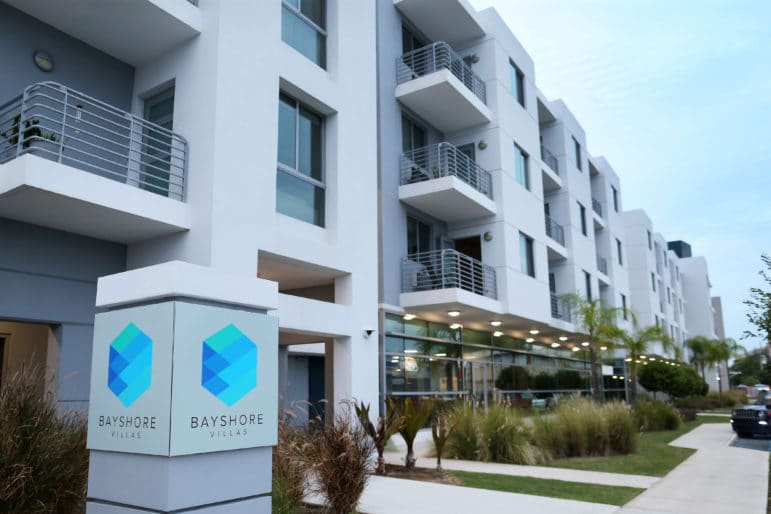
Photo by José “Pipo” Reyes | Centro de Periodismo Investigativo
She said there were residents who applied to live in the new complex but were denied. One such case is that of a retired nurse with an income of $1,200 from her pension and her Social Security benefits. “She was denied moving into the complex because she exceeded the income limits, but she currently lives in public housing,” she said.
She also mentioned the case of a mother with her two children who also did not qualify to get into the new complex because she exceeded the income limit, but currently lives in a public housing project.
She also recalled the case of a young man, who was a community leader of Las Gladiolas, who was also denied housing because he had a full-time job earning $8 an hour.
The saddest case, Colón said, was that of an older adult from Las Gladiolas. He exceeded the eligibility limits for housing in Renaissance Square by $3 a month. “Because of $36 a year, he didn’t have the opportunity to come to what was his lifelong community.”
They offered him to go to the private market, which means paying regular rent. “You tell me if with $1,200 a month you can pay for housing costing $625 plus utilities,” Colón questioned.
She said there is currently no law that provides that, after the demolition of a public housing complex, another one must be built, which she said is “dangerous” for poor people.
The McCormack Baron Salazar company developed the Renaissance Square complex, selected the tenants, and managed it.
This company later built other mixed-income complexes that replaced public housing: Bayshore Villas in Puerta de Tierra and Emerald Vista in Caguas, which consists of family housing units and an elderly home.
Carolyn Sánchez, leader of advocacy group “Puerta de Tierra no se vende,” said that only eight of the 484 families that used to live in the Residencial Puerta de Tierra housing complex now live in Bayshore Villas, which replaced it.
“Since 2000, what we’ve seen is displacement, and they kept up with their lies year after year. We are in a strategic, privileged place, and they want to get the poor people out of the neighborhood to bring in millionaires, investors, and with this (tax incentives) Act 22, everything is monopolized,” said Sánchez.
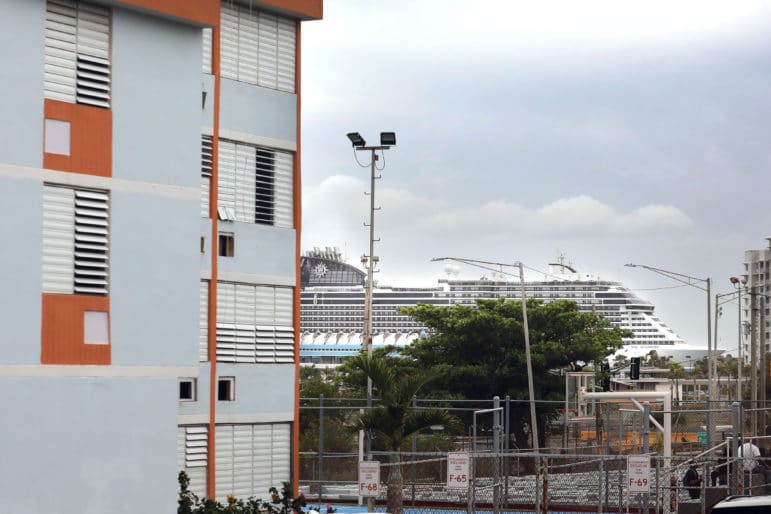
Photo by José “Pipo” Reyes | Centro de Periodismo Investigativo
Act 22 encourages that foreign investors establish themselves in Puerto Rico with tax exemptions.
Sánchez, together with the “Puerta de Tierra no se vende,” group have denounced that they have received rehousing letters from the AVP, especially in the Parque San Agustín de Puerta de Tierra residential complex where she lives, due to some alleged improvements that the AVP would be making in the buildings. She said the AVP informed the older adults in the community about the relocations, but said nothing to the rest of the residents. These older adults were the ones who let the community leaders know what was going on. Fear among residents of Puerta de Tierra of being removed from their community has led them to come together and fight for their rights.
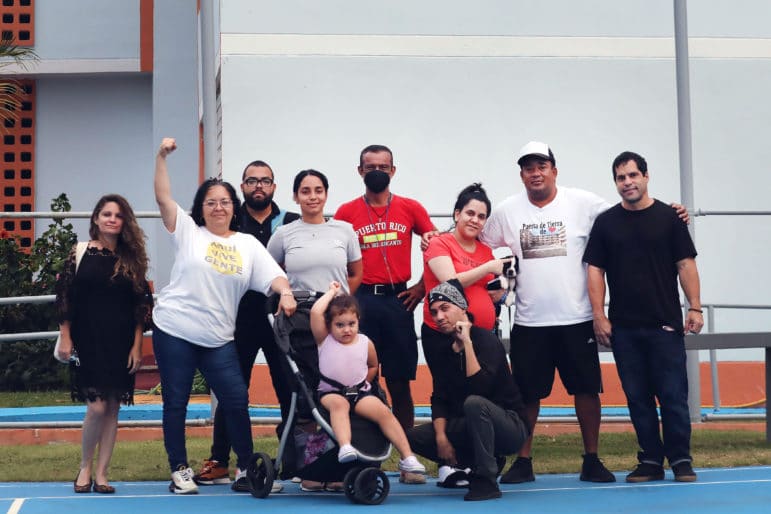
Photo by José “Pipo” Reyes | Centro de Periodismo Investigativo
She said that first they were told that the repairs are scheduled because some stairs have structural damage. Then they were told that the problem was in the roofs, showing an inconsistency in the reasons why they are going to carry out the improvements.
However, the community remains vigilant. They fear being displaced as has happened to other residents in the past who were rehoused and never returned. That was José Luis Vélez Camacho’s case.
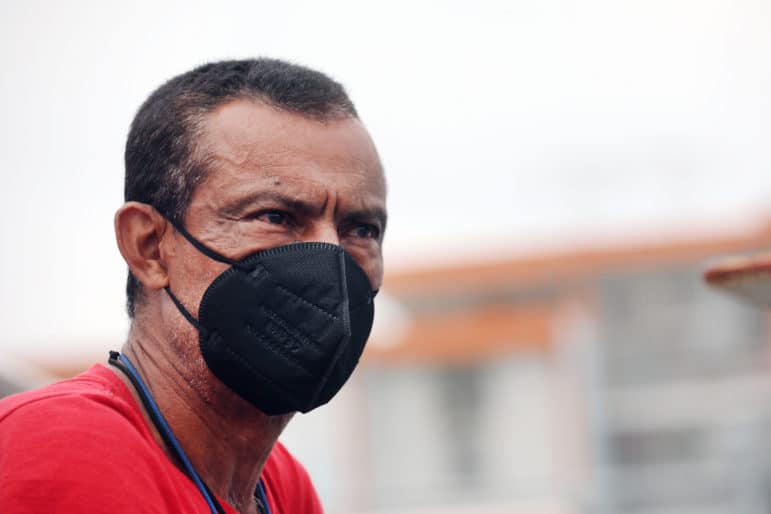
Photo by José “Pipo” Reyes | Centro de Periodismo Investigativo
The community leader of Puerta de Tierra, who currently lives in Santurce, insisted the residents were deceived. They were told they would be relocated to other developments while they built Bayshore Villas, but they never came back. Nor were they relocated to Residencial Puerta de Tierra II, which was remodeled in 2018.
“They put 60,000 obstacles in front of me [to return to Puerta de Tierra]. The people who returned can be counted on one hand,” said Vélez Camacho.
“This isn’t the end of it… We’re going to fight for our land, our place, our family, our homes, we’re going to fight it tooth and nail. We’re going to succeed because this is ours,” said Vélez Camacho.
“You take us somewhere else that we don’t know, we’re going to feel uncomfortable, we’re going to feel bad, me and all of us who are here were born in Puerta de Tierra and we want to die here, we don’t want to die abroad. We don’t want to be foreigners in our own land. They want to change our neighborhood. Instead of being called Puerta de Tierra, they want to change it now to West Condado. They’re wrong. We’re going to resist and we’re going to continue fighting for our neighborhood,” said Jorge Luis González, a resident of Residencial San Antonio, also from Puerta de Tierra, proudly wearing a T-shirt that read “Puerta de Tierra de corazón.”

Photo by José “Pipo” Reyes | Centro de Periodismo Investigativo
There are eight apartments there for people with disabilities that have been empty since before Hurricane María, which for him represents displacement. “They’re waiting for the apartments to continue to deteriorate” and then say they have to demolish them, he said.
“This relocation process was done to renovate these units and temper them to the federal requirements of laws and regulations for the accessibility of people with disabilities,” said Public Housing Administrator Salgado Colón in written statements to the CPI.
He added that “the projects haven’t been awarded because two bids have been carried out in which the proponents have presented budgets that exceed what is established. Currently, we’re reevaluating the latest proposals or if a new bidding process is necessary to move ahead with the planned remodeling to make these units accessible to people who need them.”
González lamented the loss of services that the community has suffered, since there used to be a bank, a post office, schools, a hardware store, and sports facilities, among others.
“It’s very dark at night, there is no security here, there’s nothing here. Why is it happening? It’s a way of kicking us out little by little without these services,” González said.
Jonathan Colón Reyes, a resident of Bayshore Villas and community leader, said the government failed to fulfill the commitment that Residencial Puerta de Tierra residents would come back to live in Bayshore Villas. He even said that the number of homes they built in Bayshore Villas and in Puerta de Tierra II fell short of the number that existed before in Residencial las Acacias, which was demolished in 2000, and was replaced with Residencial Puerta de Tierra II, and the Residencial Puerta de Tierra. He said more than 600 families lived in Las Acacias, and 484 in Puerta de Tierra. Bayshore currently has 174 housing units (originally, it was published that were 484 units, and was corrected on September 2, 2022), of which only eight families from Puerta de Tierra live, while in Puerta de Tierra II, only 70 of the 85 units are occupied by residents of the former housing complex.
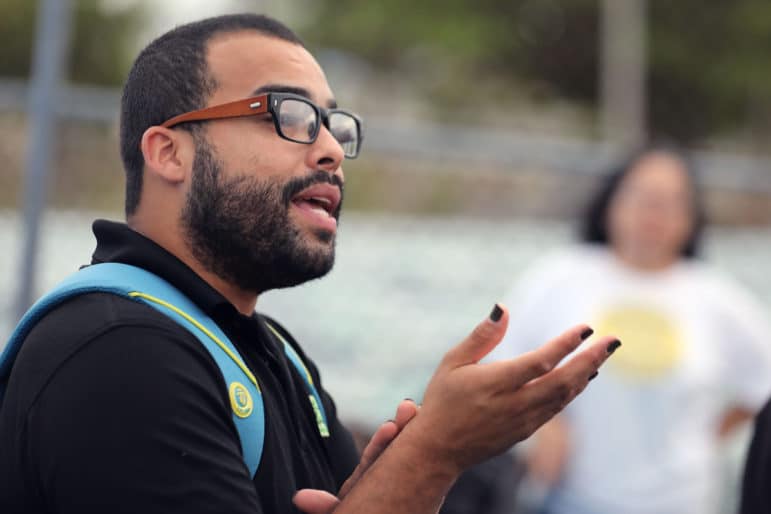
Photo by José “Pipo” Reyes | Centro de Periodismo Investigativo
Colón Reyes assured that when Residencial Puerta de Tierra was demolished, the commitment was to bring back 150 residents to Bayshore Villas.
Laura Mía González, who is a member of the community group, said that on April 8 they met with Omar Figueroa, associate administrator of the AVP’s selection and occupation division, and asked him to let them know what the AVP’s plan was for Residencial Parque San Agustín and he told them that the housing complex was going to be emptied two buildings at a time. They agreed that they would go there with the Public Housing Administrator after Easter. “We’re still waiting for them,” she assured.
She also said the agency told them in that conversation that it would not send any more relocation letters to the residents of Parque San Agustín until the group was satisfied with the plan. However, after the meeting, another resident received one of these letters.
When the CPI asked about how they would be ensuring that residents would not be displaced by the purchase of properties in that area by investors, the AVP said: “The residential complexes in Puerta de Tierra, including Parque San Agustín, are not in demolition plans nor do they have authorization from the US Department of Housing and Urban Development for demolition or disposal.”
The AVP further said: “The AVP staff, including the Secretary [of the Department of Housing] and the Administrator, have met with the Parque San Agustín community on several occasions to offer guidance on the work to be carried out on the stairs of the complex and the temporary relocation needed to carry out those repairs.”
In late January, FEMA and the Department of Housing announced the availability of $554 million in federal funds to repair public housing that was affected by Hurricane María. The Accelerated Obligation Strategy (FAASt) was applied for this allocation, which allowed a smaller sample to be inspected — 400 buildings — to then extrapolate it to the rest of the public housing complexes, Public Housing Administrator Salgado Colón explained.
He added that another $200 million in FEMA funds are also allocated, but not under the FAASt initiative, but under the National Delivery Model, which is another work model that FEMA implemented for recovery projects.
Repairs more than four years after María
AVP Administrator Salgado Colón said the bidding process for the first projects that were approved under the National Model in 2020 is currently underway: Parque Sultana, in Mayagüez; Rincón Taíno, in Santa Isabel; and Las Muñecas, in Aguadilla. They would be the first housing projects they would repair. Despite not having any contracted company at the end of March, Salgado Colón assured that work will begin this summer.
Salgado Colón said that they are in a bidding process to contract project managers, who would oversee coordination, bids and contracting, in addition to supervising the works throughout Puerto Rico.
He insisted that repairs in the housing complexes affected by María would not require the relocation of residents because they will consist of roof repairs, painting, and renovation of common areas.


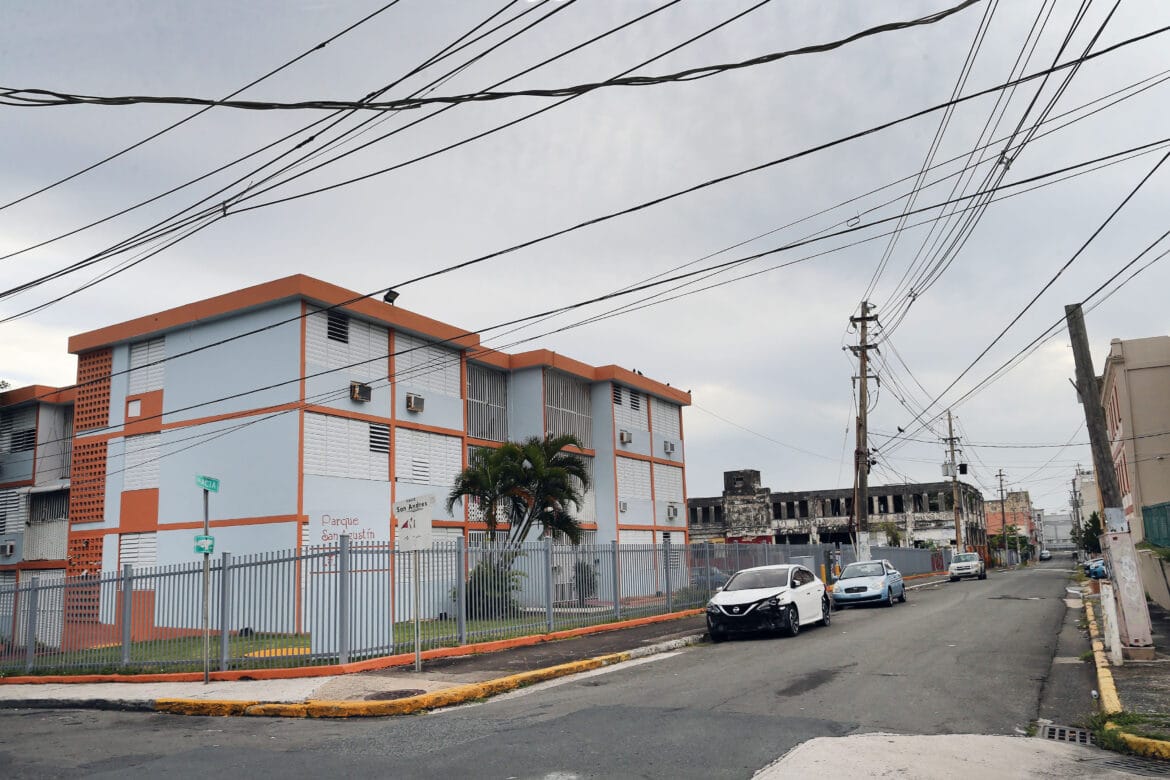

Aqui vienes Los Yankees, Dios Los ayudes.